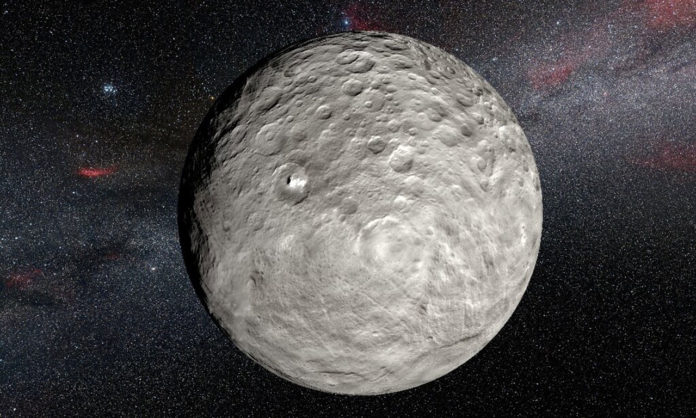The dwarf planet Ceres, which lies in the main asteroid belt between Mars and Jupiter, has a diameter of 940 km. According to a new study, this dwarf planet, which was long assumed as rocky- is an ocean world with reservoirs of seawater beneath its surface.
Scientists from the United States and Europe analyzed images obtained from NASA’s Dawn spacecraft that were captured around 35 kilometers (22 miles) from the asteroid. The images revealed crisp details of the mysterious bright regions Ceres had become known for.
Scientists had figured out that the bright areas were deposits made mostly of sodium carbonate – a compound of sodium, carbon, and oxygen. They likely came from liquid that percolated up to the surface and evaporated, leaving behind a highly reflective salt crust. But what they hadn’t yet determined was where that liquid came from.
By analyzing data collected near the end of the mission, Dawn scientists have concluded that the liquid came from a deep reservoir of brine, or salt-enriched water. They then studied Ceres’ gravity, to learn more about the dwarf planet’s internal structure and determined that the brine reservoir is about 25 miles (40 kilometers) deep and hundreds of miles wide.
The study, which focuses on Ceres’ 57-mile-wide (92-kilometer-wide) Occator Crater – home to the most extensive bright areas – confirms that Ceres is a water-rich world like these other icy bodies.
Not only that, but scientists came to know that these bright regions are young – some less than 2 million years old and the geologic activity driving these deposits could be ongoing.
On Ceres’ surface, salts bearing water quickly dehydrate, within hundreds of years. But Dawn’s measurements show they still have water, so the fluids must have reached the surface very recently. This is evidence both for the presence of liquid below the region of Occator Crater and the ongoing transfer of material from the deep interior to the surface.
Dawn Principal Investigator Carol Raymond said, “We found two main pathways that allow liquids to reach the surface. For the large deposit at Cerealia Facula, the bulk of the salts were supplied from a slushy area beneath the surface that was melted by the heat of the impact that formed the crater about 20 million years ago. The impact heat subsided after a few million years; however, the impact also created large fractures that could reach the deep, long-lived reservoir, allowing brine to continue percolating to the surface.”
Journal Reference:
- C. A. Raymond et al. Impact-driven mobilization of deep crustal brines on dwarf planet Ceres, Nature Astronomy (2020). DOI: 10.1038/s41550-020-1168-2
- A. Nathues et al. Recent cryovolcanic activity at Occator crater on Ceres, Nature Astronomy (2020). DOI: 10.1038/s41550-020-1146-8
- R. S. Park et al. Evidence of non-uniform crust of Ceres from Dawn’s high-resolution gravity data, Nature Astronomy (2020). DOI: 10.1038/s41550-020-1019-1
- M. C. De Sanctis et al. Fresh emplacement of hydrated sodium chloride on Ceres from ascending salty fluids, Nature Astronomy (2020). DOI: 10.1038/s41550-020-1138-8
- B. E. Schmidt et al. Post-impact cryo-hydrologic formation of small mounds and hills in Ceres’s Occator crater, Nature Geoscience (2020). DOI: 10.1038/s41561-020-0581-6
